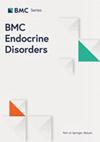甲状腺风暴小鼠模型的建立和胃泌素治疗效果的初步研究
IF 2.8
3区 医学
Q3 ENDOCRINOLOGY & METABOLISM
引用次数: 0
摘要
甲状腺风暴(TS)是一种危及生命的疾病,可损害多个器官,但治疗方法却很有限。高细胞血红蛋白血症被认为是一种背景疾病,但其病理条件尚不清楚,也没有合适的动物模型。我们的目标是通过服用三碘甲状腺原氨酸和脂多糖来建立 TS 小鼠模型,然后研究胃泌素对该模型的影响。我们评估了使用血清 IL-6 水平作为 TS 患者高细胞血红蛋白血症的代表性标记物。为了建立小鼠模型,我们进行了初步实验,以确定单独施用三碘甲状腺原氨酸和脂多糖时的非致死剂量。作为一种 TS 模型,我们给 C57BL/6 小鼠注射了三碘甲状腺原氨酸 1.0 毫克/千克(皮下注射,每天一次,连续七天)和脂多糖 0.5 毫克/千克(腹腔注射,第 7 天),从而建立了一种第 8 天存活率约为 30% 的致死模型。我们评估了存活率、小鼠败血症评分和血液生物标志物(IL-6、肾上腺素、丙氨酸氨基转移酶),并评估了胃泌素 300 µg/kg 对 TS 模型中这些参数的影响。与作为疾病对照的巴塞杜氏病患者相比,TS患者的血清IL-6升高(18.2 pg/mL vs. 2.85 pg/mL,P < .05,n = 4)。小鼠 TS 模型的剂量为三碘甲状腺原氨酸 1.0 毫克/千克和脂多糖 0.5 毫克/千克。TS 模型组的小鼠败血症评分、血清 IL-6、肾上腺素和丙氨酸氨基转移酶均有所升高。在该模型中,胃泌素可将存活率提高至 66.7%(P < .01,与 0% [生理盐水处理组]相比),并提高小鼠败血症评分,降低血清 IL-6 和肾上腺素。我们建立的 TS 动物模型表现出与人类 TS 相似的病理生理状态,通过给予 T3 和 LPS 诱导血清 IL-6 和其他生物标志物。结果表明,胃泌素对人类 TS 有潜在的疗效。本文章由计算机程序翻译,如有差异,请以英文原文为准。
Generation of a mouse model of thyroid storm and preliminary investigation of the therapeutic effects of ghrelin
Thyroid storm (TS), a life-threatening condition that can damage multiple organs, has limited therapeutic options. Hypercytokinemia is a suggested background, but the pathological condition is unclear and there are no appropriate animal models. We aimed to develop a TS mouse model by administration of triiodothyronine and lipopolysaccharide, and then to examine the effects of ghrelin on this model. We evaluated the use of serum IL-6 levels as a representative marker of hypercytokinemia in patients with TS. To establish the mouse model, preliminary experiments were conducted to determine the non-lethal doses of triiodothyronine and lipopolysaccharide when administered individually. As a TS model, C57BL/6 mice were administered with triiodothyronine 1.0 mg/kg (subcutaneously, once daily for seven consecutive days) and lipopolysaccharide 0.5 mg/kg (intraperitoneally, on day 7) to develop a lethal model with approximately 30% survival on day 8. We assessed the survival ratio, mouse sepsis scores and blood biomarkers (IL-6, metanephrine, alanine aminotransferase) and evaluated the effects of ghrelin 300 µg/kg on these parameters in TS model. Serum IL-6 was increased in patients with TS compared with those with Graves’ disease as the diseased control (18.2 vs. 2.85 pg/mL, P < .05, n = 4 each). The dosage for the murine TS model was triiodothyronine 1.0 mg/kg and lipopolysaccharide 0.5 mg/kg. The TS model group had increased mouse sepsis score, serum IL-6, metanephrine and alanine aminotransferase. In this model, the ghrelin improved the survival rate to 66.7% (P < .01, vs. 0% [saline-treated group]) as well as the mouse sepsis score, and it decreased the serum IL-6 and metanephrine. We established an animal model of TS that exhibits pathophysiological states similar to human TS with induction of serum IL-6 and other biomarkers by administration of T3 and LPS. The results suggest the potential effectiveness of ghrelin for TS in humans.
求助全文
通过发布文献求助,成功后即可免费获取论文全文。
去求助
来源期刊

BMC Endocrine Disorders
ENDOCRINOLOGY & METABOLISM-
CiteScore
4.40
自引率
0.00%
发文量
280
审稿时长
>12 weeks
期刊介绍:
BMC Endocrine Disorders is an open access, peer-reviewed journal that considers articles on all aspects of the prevention, diagnosis and management of endocrine disorders, as well as related molecular genetics, pathophysiology, and epidemiology.
 求助内容:
求助内容: 应助结果提醒方式:
应助结果提醒方式:


